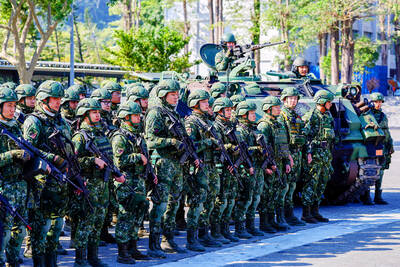Because China has never signed a treaty banning the use of cluster bombs, to maximize its military position, Taiwan will continue to include the weapons in its arsenal, the Ministry of National Defense (MND) said on Thursday.
While the majority of Taiwan’s cluster bombs are imported, the ministry said that the Chung Shan Institute of Science and Technology has made the necessary preparations to independently manufacture the bombs.
TREATY
Cluster bombs often kill innocent civilians.
On May 28, 124 countries reached an agreement on a treaty in Dublin, Ireland, that will ban the use of cluster bombs internationally. This treaty will most likely be signed in Oslo, Norway, at the end of this year.
However, the world’s main users and manufacturers of cluster bombs, including China, the US, Israel, India and Russia are against moves to ban the weapons and are not likely to sign the treaty.
A cluster bomb is loaded with smaller bomblets, which are sprayed across a wide area and are capable of causing massive damage at distances of up to 25m.
Unexploded cluster bombs left behind after attacks have killed many innocent civilians and have therefore drawn much international attention.
TAIWAN’S ARSENAL
Military officials said half of Taiwan’s RT2000 (Thunder) multiple launch rocket systems are packed with high-explosive shell types, while the other half are packed with cluster bombs.
Taiwan would use cluster bombs to attack ships in waters close to Taiwan. The bombs are dispersed across the surface of the ocean and should therefore pose no threat to civilians, the ministry said.
While cluster bombs will continue to be included in Taiwan’s arsenal for the time being, high-explosive shell bombs will be used in place of cluster bombs if the international ban succeeds.

UNILATERAL MOVES: Officials have raised concerns that Beijing could try to exert economic control over Kinmen in a key development plan next year The Civil Aviation Administration (CAA) yesterday said that China has so far failed to provide any information about a new airport expected to open next year that is less than 10km from a Taiwanese airport, raising flight safety concerns. Xiamen Xiangan International Airport is only about 3km at its closest point from the islands in Kinmen County — the scene of on-off fighting during the Cold War — and construction work can be seen and heard clearly from the Taiwan side. In a written statement sent to Reuters, the CAA said that airports close to each other need detailed advanced

Tropical Storm Fung-Wong would likely strengthen into a typhoon later today as it continues moving westward across the Pacific before heading in Taiwan’s direction next week, the Central Weather Administration (CWA) said. As of 8am, Fung-Wong was about 2,190km east-southeast of Cape Oluanpi (鵝鑾鼻), Taiwan’s southernmost point, moving westward at 25kph and possibly accelerating to 31kph, CWA data showed. The tropical storm is currently over waters east of the Philippines and still far from Taiwan, CWA forecaster Tseng Chao-cheng (曾昭誠) said, adding that it could likely strengthen into a typhoon later in the day. It is forecast to reach the South China Sea

Almost a quarter of volunteer soldiers who signed up from 2021 to last year have sought early discharge, the Legislative Yuan’s Budget Center said in a report. The report said that 12,884 of 52,674 people who volunteered in the period had sought an early exit from the military, returning NT$895.96 million (US$28.86 million) to the government. In 2021, there was a 105.34 percent rise in the volunteer recruitment rate, but the number has steadily declined since then, missing recruitment targets, the Chinese-language United Daily News said, citing the report. In 2021, only 521 volunteers dropped out of the military, the report said, citing

WEATHER Typhoon forming: CWA A tropical depression is expected to form into a typhoon as early as today, the Central Weather Administration (CWA) said yesterday, adding that the storm’s path remains uncertain. Before the weekend, it would move toward the Philippines, the agency said. Some time around Monday next week, it might reach a turning point, either veering north toward waters east of Taiwan or continuing westward across the Philippines, the CWA said. Meanwhile, the eye of Typhoon Kalmaegi was 1,310km south-southeast of Oluanpi (鵝鑾鼻), Taiwan’s southernmost point, as of 2am yesterday, it said. The storm is forecast to move through central